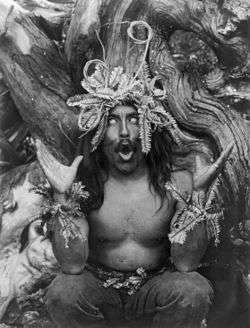Hamatsa
Hamatsa is the name of a Kwakwaka'wakw secret society. During the winter months, the Kwakwaka'wakw of British Columbia has many ceremonies practiced by different secret societies. According to the German-American anthropologist Franz Boas, who studied the Kwakwaka'wakw tribe during the late 1880s, there were four main societies: The war society (Winalagalis), the magical society (Matem), the society of the afterlife (Bakwas) and the "cannibal" society (Hamatsa).

The Hamatsa society is the most prestigious of all. It is often called the cannibal ritual, and according to Kwakwaka'wakw members, historically, literal cannibalism was practiced. However, readers should note that currently, there is no eating of humans or human flesh in the rituals.
The myth of Baxbaxwalanuksiwe
Central to the Hamatsa ceremonies is the story of some brothers who became lost while on a hunting trip and found a strange house with red smoke emanating from its roof. When they visited the house they found its owner gone, but one of the house posts was a living woman with her legs rooted into the floor, and she warned them about the frightful owner of the house, who was named Baxbaxwalanuksiwe, a man-eating giant with four terrible man-eating birds for his companions (including Gwaxwgwakwalanuksiwe'/man-eating raven; Galuxwadzuwus/ Crooked-Beak of Heaven; and Huxhukw/supernatural crane who cracks skulls of men to suck out their brains). One version of the story describes the giant with mouths all over his body.
According to another version, the brothers lured Baxbaxwalanuksiwe into a pit and threw hot stones on top of him until he died, his ashes turned into thousands of mosquitos. With the death of the giant, the men gained mystical power and supernatural treasures from him. These included wooden whistles, a bear mask, bird masks, costumes, and a Hamatsa pole, all used in later actual rituals. Variations of the myth abound within the Kwakwaka'wakw culture, but this man-eating giant was aided by an old hag, Qominoqa (possibly Dzunukwa), who gathered bodies for him to consume.
The ritual practice
In practice the Hamatsa initiate, almost always a young man (although age is irrelevant), is abducted by members of the Hamatsa society and kept in the forest in a secret location where he is instructed in the mysteries of the society. Then at a winter dance festival to which many clans and neighboring tribes are invited the spirit of the man-eating giant is evoked and the initiate is brought in wearing spruce bows and gnashing his teeth and even biting members of the audience. In a symbolic gesture of pacification, rattles are shaken by he'liqa (healers). These rattles, often made from a human skull, are also used to announce the entrances of dancers. Many dances ensue as the tale of Baxbaxwalanuksiwe is recounted, and all of the giant man-eating birds dance around the fire.
Finally the society members succeed in taming the new cannibal initiate. During the ceremonies human flesh is eaten by the initiates. Boas describes the hamatsa initiate as eating actual human flesh without chewing. After the ceremony, the initiate is forced to drink large amounts of sea water to induce vomiting, thereby voiding the body of potentially harmful toxins. All persons who were bitten during the proceedings are given expensive presents, and many gifts are given to all of the witnesses who are required to recall through their gifts the honors bestowed on the new initiate and recognize his station within the spiritual community of the clan and tribe.
See also
- Dances of the Kwakiutl, a short documentary depicting the Hamatsa ceremony
References
- The Mouth of Heaven: An Introduction to Kwakiutl Religious Thought by Irving Goldman
- Hamatsa: The Enigma of Cannibalism on the Pacific Northwest Coast by Jim McDowell
- Cannibalism, Headhunting and Human Sacrifice in North America: A History Forgotten by George Franklin Feldman
- The Social Organization and the Secret Societies of the Kwakiutl Indians by Franz Boas (1897)
External links
Further reading
- Wike, Joyce (1984). "A Reevaluation of Northwest Coast Cannibalism". In Miller, Jay; Eastman, Carol M. (eds.). The Tsimshian and Their Neighbors of the North Pacific Coast. University of Washington Press. pp. 239–254. ISBN 978-0-295-96126-2.